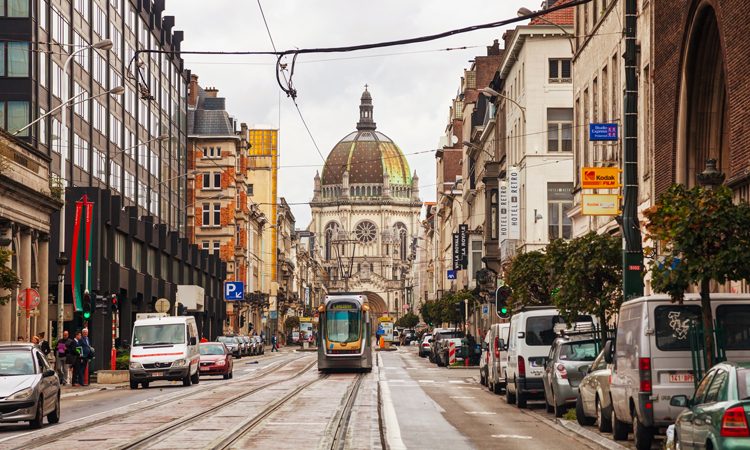Intelligent Transport’s Advisory Board Roundtable
- Like
- Digg
- Del
- Tumblr
- VKontakte
- Buffer
- Love This
- Odnoklassniki
- Meneame
- Blogger
- Amazon
- Yahoo Mail
- Gmail
- AOL
- Newsvine
- HackerNews
- Evernote
- MySpace
- Mail.ru
- Viadeo
- Line
- Comments
- Yummly
- SMS
- Viber
- Telegram
- Subscribe
- Skype
- Facebook Messenger
- Kakao
- LiveJournal
- Yammer
- Edgar
- Fintel
- Mix
- Instapaper
- Copy Link
Posted: 6 September 2018 | Brian Masson - Multi Modal Transport Solutions, Carol Schweiger - Schweiger Consulting, Ivo Cré – Polis, Jon Lamonte - Transport for Greater Manchester, Søren Sørensen - SFMCON, Thomas Kritzer - Wiener Linien, Tom Vogue - OECD | No comments yet
Ahead of InnoTrans 2018, Intelligent Transport asked our Advisory Board for their thoughts on the current state of transport and mobility, and how today’s developments and practices will affect tomorrow’s operators and passengers.


Participants:
  |
  |
  |
  |
  |
  |
  |
| Ivo Cré, Deputy Director, Polis | Thomas Kritzer, Head of Tramway Operations, Wiener Linien | Dr. Jon Lamonte, Chief Executive, Transport for Greater Manchester | Brian Masson, Director, Multi Modal Transport Solutions | Carol Schweiger, President, Schweiger Consulting | Søren Sørensen, Consultant, SFMCON | Dr. Tom Voege, Policy Analyst, International Transport Forum at the OECD |
Shared mobility solutions have changed the transport marketplace completely in the last decade; what’s the next step for integrating these solutions into urban transport networks as a whole?
CRÉ: Cities cannot absorb an endless number of shared mobility service providers, so if the market does not solve this issue, local authorities will have to step in to select the services that are best for the city’s mobility system to thrive. The shared systems will most likely be interconnected and made accessible through MaaS-type platforms, but on the other hand, I would not underestimate the capacity of specific shared services to be standalone, as well as very successful in serving a niche audience. We can expect synergies between shared mobility services for passengers and urban logistics or delivery services, as they are likely to use the same digital platforms, spaces and vehicles.
KRITZER: Customers want a seamless transportation chain and it’s extremely important to guarantee this is in place. This doesn’t rely solely on transport modes, but factors like ticketing and travel information. The existing ‘traditional’ public transport solutions must continue to be the mobility backbone that serves a city’s population – at least for the next decade or two. The services providing an average 2.5 million daily rides in Vienna will not be replaceable in the near future but can be supplemented with new shared services. A huge step will be the integration of existing systems and improving the interfaces for the customer, as we are doing in Vienna with the ‘Wien Mobil’ app.
LAMONTE: In recent years the transport sector has experienced a potentially seismic shift in direction, punctuated by advances in CASE innovation (Connected, Autonomous, Shared and Electric) coupled with an increasing consumer expectation for personalised ‘instant transport’ and declining vehicle ownership, particularly among the young.
The automotive industry initially faced real challenges from the technology sector but has now sought out new partnerships to embrace innovation and new business models. There is increasing recognition among manufacturers that the value of transport is no longer solely about selling vehicles but instead the potential of big data and its ability to capture customer insight and behaviour.
While all of the above can unlock previously unaffordable mobility solutions (particularly for the shared mobility sector) and bring forward increasingly scalable and rapidly deployable transport services, there are potential risks. It is therefore imperative that there is a coherent debate on how shared mobility solutions can benefit the public and how they should be implemented.
MASSON: Shared mobility services such as Uber and Lyft are now well established across the world. The public loves the flexibility that these services provide, but there are a number of hurdles to jump before these become more broadly accepted by the transport sector. How do we integrate large, shared mobility providers such as these into the complex, multimodal world of transport? It is important to involve communities and stakeholders in the design of mobility solutions, co-creation methods are proving valuable tools in achieving these goals. It is important that we spend time on the design of our towns, cities and rural areas to ensure the solutions we adopt really improve the lives of citizens.
SCHWEIGER: Firstly, we need to better understand the impacts of existing shared mobility solutions on congestion, safety, public transport usage, equity, accessibility, transport funding and agency collaboration. Secondly, we need to focus on determining how these innovations can complement rather than compete with public transport – there can be a negative impact on public transport when riders use more shared mobility options. Public transport – the original shared mobility solution – is the backbone of mobility in most urban areas and should continue as the leading mobility solution. We need to establish a framework that uses open and shared data from shared mobility providers to continually assess and measure the effects of providers’ services on the transport network.
SØRENSEN: To further integrate shared mobility solutions into urban transport, city planners and politicians needs to change priorities from private car to sustainable and urban-friendly means of transport. With urban roads saturated by single-occupant cars, alternative means of transport need to be prioritised for efficient urban mobility. Ride-hailing services have disrupted traditional licensed taxis, yet without regulation the use of private cars for ride-hailing will just make congestion worse. In inner cities it is faster to grab a bike for door-to-door travel compared to any other means of transport. Whether it is your own bike or a rental is not important, but cities need bicycle lanes and ample, widely-distributed bike-parking spaces.
VOEGE: These solutions are now going mainstream in markets across the world amid reduced political and regulatory conflict. This is mainly based on the increased willingness of tech companies, platform operators and cities to cooperate and integrate new services into multimodal public transport options. There has also been a clear trend towards building alliances between these companies, car manufacturers and other modes – most notably lately with free-floating, dockless bike-share schemes – and investigating new innovative services and business models. With the advent of vehicle automation, uptake of new mobility services is likely to accelerate faster. It’s a potential paradigm shift that could spell the end for car ownership as we know it.


In your view, what does ‘best practice’ look like for ensuring the future of mobility is sustainable, accessible, equitable and reliable?
CRÉ: Best practice can only be what the best fit for specific local situations is – there is no one-size-fits-all solution in this game. For local authorities, solutions that can make cities more prosperous, sustainable and equitable at a cost that is affordable for both the end user and the authorities – and that contributes in kind with data, urban space and regulatory frameworks – qualifies as best practice. These should also fit into the existing ‘background’ (working with the hardware and software legacy systems). The process in which these best practices are established is also of great importance: local authorities are more interested in smooth, planned processes enabling all stakeholders to contribute than they are in disruptive or aggressive market entries.
SCHWEIGER: Best practice must start with continually improving public transport, as typically in an urban environment it provides the majority of mobility services. However, we cannot assume that public transport is sustainable, fully accessible, equitable and reliable. While many public transport agencies are moving toward alternatively fuelled vehicles, there should be a greater shift to alternative sources of energy that are sustainable in the long run. With the advent of technology in public transport, best practice must include an assessment of the accessibility of the technology. For example, if dynamic message signs (DMS) are used to convey real-time information at a station or stop, we must ensure that the information being displayed is provided in multiple formats (e.g. audio if a rider has a visual impairment, or visual if a rider has an auditory impairment). Equity is critical in public transport, and again, the use of technology can create inequity. For example, if fare payment is available only via electronic means, we need to consider riders who are ‘unbanked’ and can only pay cash on a trip-by-trip basis.
VOEGE: Going forward, policy makers need to manage this transition period to new mobility solutions, including technology developments such as demand-matching platforms and vehicle automation, as they will enable many new business models and services. Unchecked by the public sector, and with no direct oversight, these emerging business models are unlikely to contribute to public policy goals. It is therefore key for the public sector to play an active role and develop sufficiently flexible regulatory schemes that balance public policy goals and the innovation potential of new technologies. It is of the utmost importance to be able to guarantee minimum mobility levels for citizens and society as a whole, enable cost transparency for fares and to ensure minimum levels of personal security and traffic safety.
MASSON: Best practice must start with understanding the issues that we are facing. Providing good quality journey planning, affordable fares, accessible vehicles, clean and safe infrastructure (e.g. bus stops and mobility hubs) and quicker journey times door to door are good places to start. The Netherlands, Denmark and Sweden have managed to design their cities around cycling and clean, safe, affordable public transport systems – lessons in best practice from these countries could assist operators and authorities around the world.
SØRENSEN: Best practice for reliable mobility services is difficult to establish. Car owners expect their car to start every time, but for users of scheduled transport, timely arrival and departure, and sharing a car requires a reliable number of vehicles being available when needed. Smart MaaS schemes should ensure that travellers can always get from door to door and handle disruptions without burdening the customer so they can get safely to their destination.
KRITZER: Transportation providers, whether operators, authorities or else, need to concentrate on the needs of their customers, which are changing almost as quickly as the industry. The sector needs to be extremely open minded, connected and also unhesitant to address existing and future challenges and decisions. When we think of cities, there needs to be a development of a clear vision of their future mobility offering. If this is in danger, cities will need to implement new regulations or standards to guarantee this for the citizens of our society.
LAMONTE: Cross sector collaboration is at the heart of our work. It’s only by working closely with our partners in the digital, health, educational and environmental sectors that we will be able to deliver our long-term strategy. For example, improving our air quality and building a sustainable future is at the heart of our strategic vision. Our Clean Air Plan, City Centre Transport Strategy, Made to Move and Streets for All strategies all encourage more people to use public transport and to cycle or walk for short journeys. Remaining up to date in a fast-paced industry is often challenging, it is therefore essential to work with international partners. TfGM are active members of a number of these including the European Metropolitan Transport Authorities (EMTA), International Association of Public Transport (UITP), Urban Transport Group (UTG), European Road Transport Research Advisory Council (ERTRAC) and the European Cities And Regions Networking For Innovative Transport Solutions (POLIS).
Some view Mobility-as-a-Service as the indisputable future of transport, but others are sceptical; where do you stand on this?
SØRENSEN: The critical element for MaaS is to deliver an ecosystem of access to shared cars and other mobility options outside users’ homes or within a short walking distance. The question that MaaS providers need to answer is: if travellers see the private car as guaranteed freedom of mobility, what does the MaaS ecosystem need to deliver for them to trust that they’ll still have said freedom? MaaS is difficult to achieve because it requires public and private mobility providers to supply open data and let a third party – the MaaS agent in front of the value chain – interact with the user and the provider. Regulators have the power to enforce open data and payments – Vienna and Hamburg are both examples where MaaS schemes are operated by regulators. Public and private mobility mode actors must allow other privately operated MaaS scheme agents to sell their services; without this, the concept of MaaS remains merely a concept.
CRÉ: Polis is cautious to what MaaS will bring. We went through a long process with our members to discuss this and in a recent position paper concluded that cities, regions and local transport providers are in many cases already providing integrated mobility offers, though the scale and coverage of these differs widely across the EU. Policy makers at EU and national level should take this into account. Polis members should actively consider how new mobility services might affect traditional public transport provision in their areas. Where new mobility services do develop, the policy environment (at EU, national or local level) should ensure these contribute to sustainable mobility goals, for example by being complementary to public transport provision and encouraging active modes, like walking and cycling. Whether it makes sense to encourage development of third-party private MaaS platforms will depend on local circumstances and, in particular, the level of integration of existing services.
VOEGE: There are numerous understandings and definitions of MaaS that currently exist. It’s objectives range from purely enabling unified and comprehensive platforms for information access, multimodal public transport booking and payment and ticketing services, to mobile phone style subscription services of a monthly mobility budget, based on different needs with corresponding recurring costs. The underlying aims and objectives of companies promoting and attempting to implement MaaS range from giving improved access to the plethora of mobility choices available to consumers and passengers, to purely commercial interests. The latter might prove problematic going forward, promoting a more sceptical view of this approach. While certain aspects look promising, a clear analysis of the changes to mobility patterns must be carried out when testing these types of systems. Any number of undesired effects might emerge, creating the need for policy actions to be introduced.
MASSON: MaaS is being hailed as the solution to all our mobility needs. The ability to develop an app to pay and access services looks like the perfect tool to achieve this goal, but the reality is far more complex. Yes, we have the technology to broker the needs of users with the supply chain, but how does the agency make money? Operators don’t want to give up revenues, authorities don’t want to share budgets or savings and users don’t want to pay more. In theory, operators and authorities could be dealing with many agencies offering MaaS solutions, but how sustainable will they be? The new wave of ride-hailing companies are yet to announce profits. MaaS is a very complex business model in which to achieve a sustainable rate of return.
LAMONTE: This is an area that TfGM has been exploring in-depth and we are in a good position as a key partner of several funded MaaS research and development projects to explore its possibilities. Taken at face value, the concept of MaaS is difficult to argue against: who wouldn’t want an integrated, personalised, all-in-one solution that provides tailored information? The practicalities and implications of MaaS, however, do require significant consideration. It became clear to me early on that MaaS cannot be a commercial proposition alone when it has the potential to support and deliver so many of our city-region’s transport objectives; MaaS has the potential to act as a traffic demand management tool, an aggregator of real-time data, a predictive tool and a way to encourage active travel. With all of this on the table it would be wrong to dismiss it without exploring the possibilities.


What should regulators be doing to ensure that constant improvements in transport – technological or otherwise – aren’t being inhibited?
LAMONTE: This is an interesting and important area. As innovation creates new scalable mobility solutions and improved ways of interacting with customers the opportunities seem limitless, but we must be careful of new issues and risks. New transport innovations are emerging more and more rapidly and in some cases the legislation does not exist to respond to them. Cities must therefore take an intelligent approach with mobility service providers.
Greater Manchester has a strong record of delivering innovative demonstrator projects, but there is still scope for creating a more structured process, such as a regulatory sandbox: an invitation to innovators to test and deploy solutions within the city-region. There is clearly more work needed across the industry to see the future technology roadmap. Cities would do well to review current specifications within contracts to understand how innovation can be accommodated and more importantly how service providers can be incentivised to continually innovate and improve.
CRÉ: For local authorities, there should be a clear vision on how the urban mobility system can serve important societal goals such as economic development, energy efficiency, space efficiency, liveability and clean air. A lot of cities develop sustainable urban mobility plans (SUMPs) to bring this vision together and define a path towards implementing that vision, but it is not easy to make these plans futureproof and allow for sufficient ‘breathing space’ to incorporate innovation throughout the plan’s lifetime. That said, there are several cities and regions that have managed to strike the balance between long-term planning and flexible implementation in view of innovations appearing on the radar. A good example is TfGM and the framework of its Local Transport Plan. TfGM annually monitors six fields influencing the plan’s roll out: policy and governance, environment and resources, urban development, society and community, economy and employment, plus technology and innovation. It is not only important to be aware of and engage with innovators, but also to understand how well new solutions are being accepted and adopted by various stakeholder groups (e.g. businesses or families).
To enable innovation, it is also important that innovators can approach the city: a dedicated desk or person to deal with requests from new mobility service providers, supply information on procedures, or even give templated information to those with new ideas or those who require support from the city, can help.
VOEGE: There appears to be a growing time lag between new transport business models enabled by technology innovation and the related policy response. This can clearly be seen with higher levels of vehicle automation (SAE level three and above), particularly with the emergence of over-the-air updates, making vehicle ‘behaviour’ potentially different from one moment to the other, vis-à-vis current ex-ante vehicle type approval regulations. There is a need for more agile and flexible regulatory frameworks, potentially requiring a paradigm shift in governance models to address the paradigm shift in mobility service provision. With the advent of big data in transport and the relating breakthroughs we have witnessed in the fields of data science and data analytics, there is a potential in this context for a move to data-driven transport policies and regulations.
MASSON: Innovation should be relatively easy: identify a problem and solve it. The trouble is that the transport sector is highly regulated and traditionally set in its methods of operation. Uber is an example of innovation that meets customer requirements but conflicts with existing working practices. In reality, solving one problem will always create another type of issue to address. We need to create frameworks that do not create monopolies or restrict new working practices. We need to remember that the real problems we’re trying to solve are to provide safe, clean, attractive places to live, work and visit. We are all part of the problem and can all be part of the solution.
SCHWEIGER: Regulators should be focusing first on transport safety and second on mobility as they develop standards and regulations. In the U.S., the current administration wants less regulation overall, but technological transport solutions such as automated vehicles must be regulated and monitored to ensure safety. However, since politics play a role in regulation, it is hard to determine the degree to which regulation will hinder progress and continuous improvements in transport. If we had a way of determining the cost of regulation against the cost of the free market in terms of transport improvement, it would be easier to determine the degree to which transport innovations should be regulated. If the political will is behind the innovators, less regulation may win out.
SØRENSEN: Regulators can help by creating attractive conditions for shared mobility and MaaS actors. To get more people to give up their own car, viable and trustworthy alternatives need to be presented. Companies need a long-term commitment on good framework conditions for investing in the inventory necessary to build the variety of shared mobility options desired. Pilots created by cities and other public regulatory powers are interesting, but if you really want people to give up car ownership you need to present an accumulation of reliable, ongoing shared mobility services.
KRITZER: As in a lot of sectors it is extremely challenging for society and also for authorities to keep pace with the ongoing developments in our lives. Digitalisation, Industry 4.0 – it will not be possible to prohibit the developments this era brings. In all businesses, we will need to change our approach, our habits and our procedures, as well as the speed at which we are making decisions. Regulators should develop a clear vision of future mobility approaches and anticipate proactive upcoming developments.
How do regulators, authorities and operators ensure they’re all on the same page when it comes to passenger safety? What improvements could be made in this area, and how can technology help?
KRITZER: In times of deregulation this is even more important. It will be necessary to act with great openness and responsible mindset. Cooperation and coordination are key. New mobility solutions and concepts are emerging, and will continue to emerge, faster than they ever have. It is necessary to have clear standards and legislation on passenger safety and also an expectation that any new mobility players will respect and fulfil those standards. No business can ever risk a passenger’s safety. If we see future developments, like autonomous driving, becoming more frequent on our roads, this will be even more important. Authorities have enormous responsibility to develop the necessary regulations to enable new forms of mobility. Technology can be a great help in achieving the necessary safety standards, supporting operations and aiding users.
CRÉ: This is a problematic area. At European level, the various passenger rights regulations cover only part of the variety of modes offering transport services. Multimodal passenger rights (along the trip chain) are not defined, neither are rights relating to those spaces where multimodality takes place, like interchanges or stations. Local authorities are affected in many ways: they manage these spaces, run or regulate transport services and are the policing authorities overseeing traffic and personal safety and security.
VOEGE: The concepts of e-hailing and ride-hailing – having started from shared economy thinking, where a neutral platform offers an unregulated marketplace between supply of drivers with cars and demand of origin to destination trips by passengers – has evolved in many markets to much higher levels of regulation, oversight, labour market aspects and access to data. This shows a clear need for universal minimum standards when it comes to passenger safety. With the likely addition of vehicle automation to mobility services and business models, a further safety focus will be placed on the tech industry and vehicle manufacturers.
MASSON: The safety of passengers must be the number one priority for all stakeholders. There is a need for each town, city and region to have user groups to discuss service design, products and safety issues. This will become increasingly important as we move to multi-operator, multimodal services. There will be a need to have consistent standards across all modes – joined up working practices and reporting procedures are essential to success. The public need to trust the systems we operate and should be involved in the design of infrastructure, services and products.
SCHWEIGER: Ensuring passenger safety should always be the number one goal for any authority and operator. Passenger safety should be the number one priority of regulators as well, but the political nature of transport plays a role and it may not end up being the case. However, cooperation between these groups could lead to the analysis of the current state of transport safety and joint determination of the standards and regulations needed to achieve zero deaths and ensure traveller protection.
SØRENSEN: Safety is a key element of regulation. Physical safety is pretty much regulated for each mode of transport, yet safety from assaults when using platform-based ride-sharing and ride-hailing services are still unchartered territory. Insurance is also an element that requires further regulatory work – what rights and protection do users have when using shared services delivered by private firms? In a chain of multimodal services, who is responsible for passenger safety when transferring from one mode to another? The MaaS provider may be required by regulation to protect the user from the start to the end of their journey, including the transfer and wait time.
LAMONTE: It must be made clear that it is the transport operator’s responsibility to meet the safety standards and regulations in their contracts and licencing agreements. Where there is evidence that an operator is not complying, authorities have the grounds to terminate that contract if the operator fails to provide evidence that actions will be taken to ensure passenger safety and reduce future risks. In technological terms, telematic data could greatly enhance our understanding of passenger safety, particularly after an incident or event. Future proofing our services is high on our agenda, as we have all seen how quickly technology develops and as a public transport authority, it is our responsibility that we keep up to date and implement these changes.
Related topics
Air Quality, Business Models, Fleet Management & Maintenance, Multimodality, On-Demand Transport, Passenger Accessibility, Passenger Experience, Sustainable Urban Transport, Ticketing & Payments, Transport Governance & Policy, Vehicle & Passenger Safety
Issue
Issue 3 2018
Related organisations
Multi Modal Transport Solutions Ltd, OECD, Polis, Schweiger Consulting LLC, SFMCON, Transport for Greater Manchester (TfGM), Wiener Linien
Related people
Brian Masson, Carol Schweiger, Dr. Tom Voege, Ivo Cré, Jon Lamonte, Søren Sørensen, Thomas Kritzer








